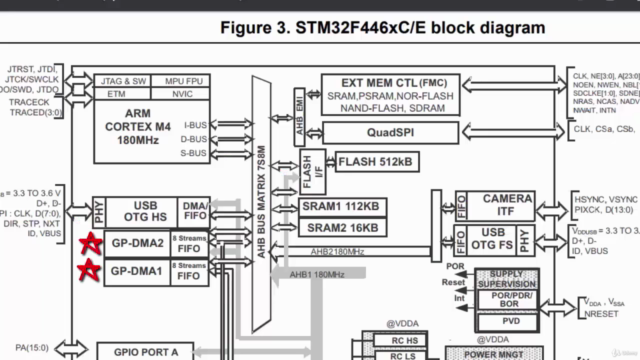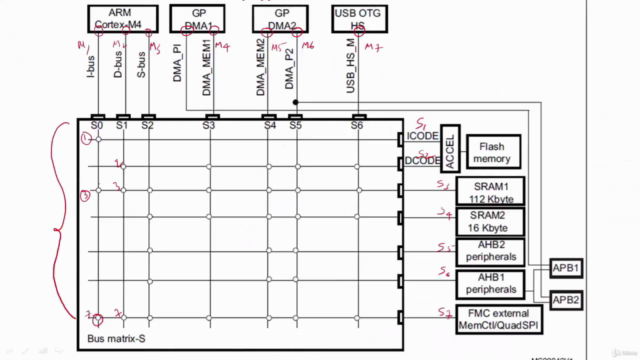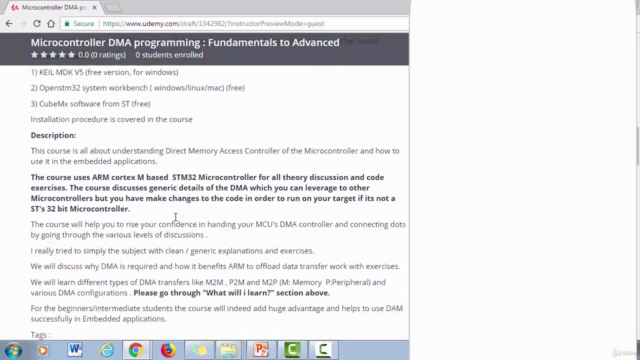ARM Cortex M Microcontroller DMA Programming Demystified

Why take this course?
🚀 Course Title: ARM Cortex M Microcontroller DMA Programming Demystified 🎓
Course Headline:
Direct Memory Access Demystified with STM32 Peripherals (ADC, SRAM, UART, M2M, M2P, P2M) and Embedded C code Exercises
Course Description:
🎥 Overview: This course is meticulously designed to unravel the intricacies of the Microcontroller DMA (Direct Memory Access) controller for embedded systems enthusiasts. It caters to beginners and intermediate learners, offering a comprehensive understanding of DMA programming with various peripherals using ARM Cortex M-based STM32 Microcontrollers and Embedded C code.
🔍 What You Will Learn:
- The Multi AHB bus matrix and ARM Cortex M Bus interfaces 🌐
- MCU Master and Slave communication over the bus matrix ⤫
- DMA internals: channel mapping, streams, FIFO, Master ports, Arbiter, etc. 🛠️
- Different DMA transfer modes: M2P, P2M, and M2M ↔️
- DMA with peripherals like ADC, GPIO, UART_RX/TX, and more! 🚀
- DMA programming from scratch 📝
- Advanced topics including circular mode, burst transfer, and RTOS support will be covered in additional videos. 🤖
Hardware Used:
- STM32F446RE Nucleo64 board 🖥️
- Compatible with other STM32 boards such as Discovery, Evaluation boards, etc.
Software Used:
- KEIL MDK V5 (free version, for Windows) 💻
- OpenSTMCube System Workbench (Windows/Linux/macOS) (free) 🛠️
- STM32CubeMX software from ST (free) 🌟
Installation Procedure:
The course includes a step-by-step guide to set up your environment for hands-on learning.
Course Content:
This course delves into the DMA controller of Microcontrollers, with a focus on the ARM Cortex M-based STM32 family. You'll gain confidence in utilizing DMA for efficient data transfer operations in embedded applications. The explanations are designed to be clear and generic, making them applicable to a wide range of microcontrollers beyond the STM32 platform.
📚 Key Components:
- Understanding why DMA is essential and its benefits for ARM processors 🧠
- Exploring different types of DMA transfers (M2M, P2M, M2P) and their configurations 🔄
- Practical exercises to solidify your understanding of DMA in embedded systems
Recommended Learning Path for Beginners:
- Microcontroller Embedded C Programming: absolute beginners (Embedded C) 🏗️
- Embedded Systems Programming on ARM Cortex-M3/M4 Processor (ARM Cortex M4 Processor specific) 🔋
- Mastering Microcontroller with Embedded Driver Development (MCU1) 🚦
- Mastering Microcontroller: TIMERS, PWM, CAN, RTC, LOW POWER (MCU2) 🌞
- Mastering Microcontroller: STM32-LTDC, LCD-TFT, LVGL (MCU3) 🖱️
- Embedded System Design using UML State Machines (State machine) ⚙️
- Mastering RTOS: Hands-on FreeRTOS and STM32Fx with Debugging (RTOS) 🛠️
- ARM Cortex M Microcontroller DMA Programming Demystified (This Course!) 🚀
- STM32Fx Microcontroller Custom Bootloader Development (Bootloader) 🔄
- Embedded Linux Step by Step using Beaglebone Black (Linux) 🐧
- Linux device driver programming using Beaglebone Black (LDD1) 🖥️
Dive into the world of embedded systems with this comprehensive course, and master the art of DMA programming for STM32 microcontrollers. Whether you're a beginner or an intermediate learner, this course will equip you with the skills to handle complex data transfer tasks efficiently. 🎥✨
Course Gallery




Loading charts...
Comidoc Review
Our Verdict
With an effective balance between foundational concepts and hands-on exercises, the DMA Programming Demystified course stands out. It offers an engaging learning experience for those interested in mastering the intricacies of Direct Memory Access with ARM Cortex M microcontrollers, despite a minor variation from the reported syllabus. Furthermore, potential learners can anticipate insights into various aspects of STM32 programming within this Udemy course.
What We Liked
- Comprehensive coverage of DMA architecture and use on ARM Cortex M3/M4 microcontrollers, with a focus on STM32F
- Complemented with exercises and real-world scenarios for practicing and applying DMA concepts
- Instructor provides clear explanations and maintains an appropriate pace throughout the course, suitable for both beginners and experienced learners
- The course design encourages the exploration of other CORTEX M3/M4 microcontrollers and IDEs
Potential Drawbacks
- Certain topics, such as circular buffer mode and burst mode, are mentioned but not fully covered during the reported timeframe
- A minority of learners suggest that adjustments to the presentation pace could cater better to experienced individuals
- Some of the course material might be confusing when dealing with simultaneous scrolling of program listings and documentation
- Could benefit from a more thorough practical example, possibly incorporating ADC data, displaying it on an LCD via SPI/I2C or discussing PWM applications and other scenarios